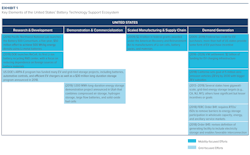Breakthrough Batteries, Part 3: Implications and Recommendations for Utility Leaders
In previous articles in this series based on the Rocky Mountain Institute's (RMI) research, we explored how rapid improvements in lithium-ion (Li-ion) batteries have unleashed massive investments in breakthrough battery technology, and considered key alternatives to Li-ion that may suit grid-tied use cases.
This third and final article explores implications for grid-tied storage in the United States, concluding with recommendations for utility sector leaders.
Implications for Utilities and Other Ecosystem Actors in the United States
The current state of government and other ecosystem support for battery storage technology focuses heavily on mobility applications and encouraging domestic manufacturing capacity, with emerging efforts tailored to grid-tied storage applications.
In this section, we will examine battery technology support ecosystems in the United States, as well as in a global context among the three other largest greenhouse-gas emitters (China, the European Union, and India).
Two Major Trends are Evident Across Each Ecosystem
Mobility markets are driving demand and cost declines. The anticipated exponential growth in EV adoption has driven government focus primarily toward mobile applications for advanced battery technologies.
- End-use demand support in the form of EV targets or incentives (or outright bans on internal combustion engine vehicles) are the most common shared elements. More recently, several countries have announced investments to support advanced research and development (R&D), or to bolster the development of domestic battery manufacturing capacity.
- The nascent grid storage market is about to take off. Manufacturing and supply chain-focused support specifically for grid-focused storage are harder to find. More effort is currently focused on ongoing R&D, demonstration projects, and, in particular, regulations to better enable storage to compete on level terms with primary power sources. In the past two years, the United States, China, and the European Commission have all taken steps to allow energy storage better access to power markets. As utilities, grid operators, and integrators gain more experience with Li-ion and other advanced (and longer-duration) batteries, cost and regulatory barriers will quickly diminish, unlocking a flood of new storage demand to balance the variability of renewable energy generation with zero emissions.
Globally, China currently dominates the advanced battery market, thanks in large part to its early support for EVs and domestic manufacturing, and its relatively consistent, large-scale efforts since. The magnitude of its targets and the associated subsidies (~US$10,000 per vehicle produced) have been key drivers for a surge in battery and vehicle manufacturing. While many vehicle manufacturers may wind down as subsidies tighten, market leaders will have gained a significant lead in production volumes and associated learning rates compared with their global competitors.
The European Commission for its part has briskly accelerated support for the advanced battery value chain over the past three years, driven largely by a fear of dependence on and lost economic opportunity to China and the rest of Asia. Analysts now expect Europe to overtake the United States in terms of installed manufacturing capacity in the next few years. Notably, a large share of that new capacity will be built by Chinese and other Asian companies.
Meanwhile India has made significant progress in the past two years in signaling its commitment to both an electric fleet and supporting a robust domestic industry across the EV value chain, including battery and cell manufacturing. As evidenced by the adoption of the National Mission on Transformative Mobility and Battery Storage, India's ministers appear determined to maximize the economic benefits of a swift shift to electric mobility in India's rapidly growing urban areas.
By contrast, the United States has taken more of a start-and-stop approach. U.S. demand for EVs has grown steadily thanks to a combination of federal tax credits and state and local incentives. However, lack of more cohesive or comprehensive federal support has kept demand growth to only a fraction of that seen in China and has not been enough to drive significant domestic battery manufacturing capacity. Some analysts cite the lack of consistent federal EV demand support as a critical contributor to what may be future U.S. dependence on Chinese suppliers.
On grid-tied storage, the United States has taken some significant initial steps to support market development, but it remains unclear whether the speed and scale of those efforts will be enough to accelerate adoption in places without supporting state policy. These efforts include a handful of state-level energy storage targets and incentives, as well as the Federal Energy Regulatory Commission's (FERC) adoption of two orders that would facilitate batteries' participation in electricity markets. However, the details of how grid operators will address those FERC requirements are still pending. Just this month, the U.S. Department of Energy (DOE) also announced an Energy Storage Grand Challenge that will aim to improve R&D and commercialization efforts in the United States, but as of this article's publication there are few details on the associated timing or budgetary commitment.
Six Recommendations for U.S. Utility Leaders Anticipating Change
Utility leaders, like any ecosystem actor, must look ahead to understand how fast-evolving battery technology will speed up the transition to zero-carbon grids and usher in an era of clean electrification.
The rate of change in the battery space is outpacing the adaptive capacity of the electricity sector to integrate new solutions. Dramatically decreasing storage costs will disrupt conventional assumptions about optimal grid architectures and open a widening array of opportunities for delivering energy services. Utilities and regulators alike must build scenarios based on forward price curves to assess the possible implications of falling prices for batteries and renewable power in order to minimize the risks of investing in assets that could soon be stranded. The synergies now emerging from the smart combination of renewable supply, storage, and demand flexibility will require new methods of planning and analysis as well as revamped utility business models.
As Li-ion battery costs and performance continue to steadily improve, ecosystem actors may also be tempted to assume the long-term dominance of this chemistry across applications. However, RMI research has shown that these improvements will instead create footholds for a divergent set of battery technologies with performance characteristics that are better suited to those use cases than today's Li-ion batteries.
The six key recommendations for utility leaders and regulators are:
1. Update resource planning processes with current information. Work collaboratively to ensure that electric utility, grid operator, state, and regional planning efforts (including integrated resource plans) are aligned to adopt realistic, forward-looking assumptions and scenarios about the fast falling costs of storage and renewable energy technologies.
2. Level the playing field between storage and other demand side resources. Develop planning and procurement, as well as measurement reporting and verification (MRV) approaches that create equal opportunity among utility-owned storage, customer-owned storage, and demand side flexibility resources. Drive toward all-source flexibility resource procurements (versus storage-only procurements).
3. Develop pathways to integrate storage at different levels of grid operation and control. Energy storage can provide enormous value to the grid under several paradigms, including customer-owned and operated storage and vehicle charging subject to distributed control. Another option is dispatchable distribution-level storage resources controlled by distribution grid operators. Another pathway may be dispatch or market-controlled flexibility resources linked to wholesale markets.
4. Invest in research-backed utility pilot programs. Consider innovative ways to develop experience with procurement and integration of grid-tied storage.
5. Support common tools and data reporting for levelized cost of storage (LCOS). Create tools and data platforms that can help understand LCOS under various duty cycles and revenue-stacking value propositions.
6. Broaden the scope of opportunity. Disaggregate grid-flexibility resource procurements so that short-term and longer-term storage technologies can be optimized to meet different needs; move beyond procurements for four-hour storage. Also consider longer-term procurement contracts to help new entrants diminish risk and orient toward longer-term thinking. Finally, look beyond Li-ion for competitive grid storage options (for example, zinc and flow batteries).
Ultimately all ecosystem actors, from utility leaders to policymakers and investors, must think comprehensively and strategically about opportunities in the looming storage market. The market will grow rapidly. While Li-ion will dominate in the near team, new technologies (both advanced Li-ion and alternative chemistries) will unlock additional applications sooner than expected. Consider areas where such nascent opportunities could emerge by keeping up to date on new technologies and how they can help solve emerging energy transition challenges in your own utility business.
Opportunities in grid-connected EV storage are only the beginning — and maybe not even the most interesting — of potential wide-scale disruptive changes in multiple industries, including transmission and distribution. Smart investors and operators will look for and find vast areas of innovation waiting to be plugged in.
For more information and citations on these industry implications and recommendations, please refer to the RMI's Breakthrough Batteries report.
About the Author
Charlie Bloch
Charlie Bloch is a principal, emerging solutions, at the Rocky Mountain Institute (RMI), where he leads cross-sector collaboration, strategy, and opportunity development within the global energy transition. His underlying interest is in leveraging technology to improve global prosperity and the environment through innovative finance, partnership, and business models. Charlie’s nearly 20-year career comprises a wide range of sustainability subject matter expertise, including utilities, clean energy, distributed energy resources, public water infrastructure, and alternative transportation. That background combined with a mix of consulting, corporate, governmental, and entrepreneurial roles provides a diverse perspective for fostering cross-sectoral collaboration and helping to bring innovative ideas to market.
Madeline Tyson
Madeline Tyson is a senior associate, emerging solutions, at Rocky Mountain Institute (RMI). She works on the emerging solutions team to evaluate promising nascent storage value propositions with cities on community scale solar. She has diverse expertise ranging from complex system analysis to techno-economic analysis to sustainable energy project development. She received her PhD from Arizona State University (ASU) where she explored energy system transitions through the lens of information management using agent-based models and regulatory analysis.

